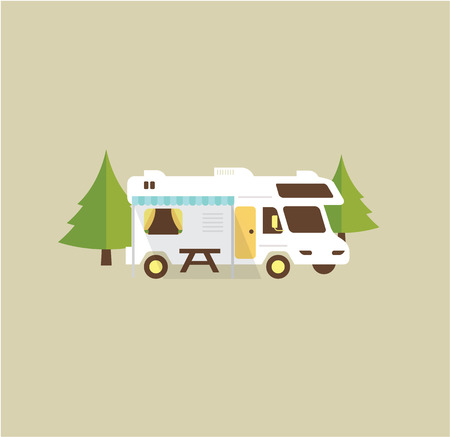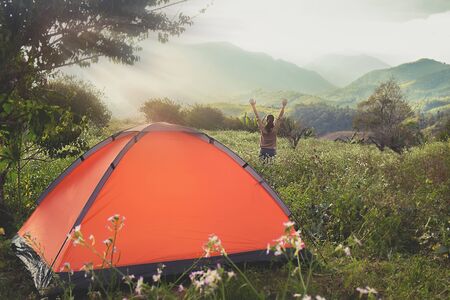1. Choosing Your Campsite Wisely
Setting up your tent isn’t just about finding a flat patch of ground and calling it home for the night. In public campgrounds across the U.S., campsite etiquette is all about balancing personal comfort, respect for other campers, and care for the environment. Here are some practical tips to help you pick the perfect tent spot while following campground rules, protecting nature, and ensuring everyone has a great outdoor experience.
Follow Park Rules and Guidelines
Most public campgrounds have clear rules about where tents can be pitched. Always check posted signs or ask a park ranger if you’re unsure. Some areas are off-limits to protect wildlife or fragile plants, while others may require tents to be set up only on designated pads or gravel spots.
Common Campsite Rules Table
| Rule | Why It Matters |
|---|---|
| Pitch tents in designated areas | Protects natural habitat and prevents overcrowding |
| No digging trenches around tents | Keeps soil intact and prevents erosion |
| Respect quiet hours | Makes the campground enjoyable for everyone |
| No tying items to trees | Prevents damage to bark and branches |
Consider Privacy and Neighborly Space
A little space goes a long way in making sure everyone enjoys their stay. Look for a spot that isn’t too close to neighboring tents or RVs. If there are no marked sites, give at least 20-30 feet between your tent and someone else’s setup when possible. Avoid blocking pathways or access to shared amenities like bathrooms or water spigots.
Quick Tips for Privacy:
- Use natural features (like bushes or trees) as gentle screens between campsites.
- Position your tent so doors face away from high-traffic paths.
- If you arrive late, keep noise down and use headlamps instead of bright lanterns.
Be Mindful of Environmental Impact
Your campsite choice can have a lasting effect on the land. Stick to existing campsites whenever possible—this helps minimize human impact on the wilderness. Avoid setting up on delicate grass, wildflowers, or near streams where erosion is a concern.
Eco-Friendly Spot Selection Checklist:
- Choose durable surfaces like dirt, gravel, or established pads.
- Avoid pitching tents under dead trees (widowmakers) or low-hanging branches.
- Stay at least 200 feet from lakes and streams to protect water quality.
- Packing out what you pack in keeps the site clean for future visitors.
2. Respecting Boundaries and Neighboring Campers
When setting up your tent in a public campground, being mindful of other campers is key to creating a positive outdoor experience for everyone. Respecting personal space, observing quiet hours, and practicing neighborly manners will help you blend right in with the local camping community.
Guidelines for Personal Space
Public campgrounds typically have designated areas for each group. To make sure everyone feels comfortable, always set up your tent within your assigned campsite boundaries. Avoid stretching out tarps, ropes, or gear into neighboring sites. If youre unsure where your space ends, ask the campground host or check the site map.
| What to Do | What to Avoid |
|---|---|
| Pitch your tent within your reserved spot | Setting up too close to another camper’s tent |
| Keep walkways clear for others | Blocking shared paths with equipment or chairs |
| Use only the picnic table and fire ring at your site | Trespassing onto adjacent campsites amenities |
Observing Quiet Hours
Most American campgrounds have posted quiet hours, usually from around 10 p.m. to 6 a.m. During this time, keep voices low, turn off music, and avoid running generators or car engines. Remember that sound travels easily outdoors—what seems like a small noise can disturb someone trying to rest nearby.
Typical Quiet Hour Etiquette
- No loud conversations or laughter late at night
- Dim lights and lanterns after dark
- If arriving late, set up quietly and quickly
- Avoid slamming car doors or using bright headlights near sleeping tents
Practicing Friendly Campsite Manners
A little friendliness goes a long way! Greet neighbors with a smile or a wave as you pass by. If youre traveling with kids or pets, remind them to stay within your site. Share communal spaces like bathrooms and water spigots fairly—wait your turn and leave things clean for the next camper.
Campsite Manners Checklist
- Introduce yourself if you feel comfortable—it builds community!
- Respect privacy; don’t walk through occupied campsites as shortcuts
- Keep pets leashed and clean up after them promptly
- If hosting friends, keep gatherings contained and respectful of others’ space and peace
- Tidy up before leaving; leave no trace behind for the next guest

3. Proper Tent Placement and Setup
Step-by-Step Guide to Pitching Your Tent the Right Way
Setting up your tent might seem straightforward, but picking the perfect spot and pitching it with care can make or break your camping experience. Here’s how to do it right, American campground style:
Step 1: Scout Your Campsite
When you arrive, take a few minutes to walk around your assigned site. Look for these key features before unloading your gear:
| What to Look For | Why It Matters |
|---|---|
| Flat Terrain | Prevents rolling while you sleep and keeps your tent stable |
| High Ground | Avoids puddling and flooding if it rains |
| Distance from Fire Pit | Keeps your tent safe from sparks and smoke |
| Shade (if available) | Keeps your tent cooler during hot days |
| Campground Flow | Makes sure you’re not blocking paths or neighbor access |
Step 2: Mind the Campground Rules and Neighbors
Every public campground has its own guidelines. Make sure you:
- Set up only within designated tent areas—never on vegetation or closed-off spots.
- Respect neighboring campers’ space; keep a reasonable distance between tents.
- Avoid setting up right next to bathrooms or trailheads for privacy and reduced foot traffic.
Step 3: Prep the Ground
Clear away sticks, rocks, and pinecones where your tent will go. This makes for a comfier sleep and helps protect your tent floor from punctures.
Step 4: Consider Drainage Direction
If there’s any slope at all, position your tent so that water flows away from the entrance. Avoid dips where rainwater could collect under you overnight.
Tent Orientation Tips:
- If possible, face your door toward a nice view—or at least away from wind direction.
- Keep entrances clear of busy walkways to avoid tripping hazards.
Step 5: Set Up Your Tent Securely
Follow these basics for a sturdy setup:
- Lay down a ground tarp or footprint to protect against moisture and wear.
- Assemble your poles and stake corners tightly; double-check guy lines are taut.
- If windy, use extra stakes or tie-downs for security—no one likes chasing their tent in the middle of the night!
- Keep zippers closed when not in use to keep bugs out and warmth in.
Your Home Away From Home
A little attention to detail goes a long way when pitching your tent. Not only will you stay safer and drier, but you’ll also help keep the campground pleasant for everyone else enjoying the great outdoors alongside you.
4. Leave No Trace Principles
When setting up your tent in a public campground, following the Leave No Trace principles is key to being a respectful and eco-friendly camper. These simple habits help keep our parks beautiful for everyone and protect the local environment. Here’s how you can minimize your impact during your stay:
Essential Habits for a Clean Campsite
| Habit | What It Means | Easy Tips |
|---|---|---|
| Pack It In, Pack It Out | Take all trash and belongings with you when you leave. | Bring extra garbage bags; check your site before leaving. |
| Stay on Established Sites | Pitch tents only in designated areas to avoid damaging plants. | Look for cleared, flat spots or marked tent pads. |
| Respect Wildlife | Avoid feeding or approaching animals. | Keep food stored securely in bear-proof containers or cars. |
| Minimize Campfire Impact | Only use existing fire rings and keep fires small. | Bring your own firewood if allowed; never burn trash. |
| Be Mindful of Noise | Keep noise levels down, especially at night. | Use quiet voices and turn off music after dark. |
| Leave What You Find | Don’t pick plants or move rocks and logs around unnecessarily. | Take photos instead of souvenirs; keep nature undisturbed. |
Campsite Cleanliness Checklist
- Tidy Up Daily: Store food, sweep up crumbs, and bag trash each night.
- No Soap in Streams: Wash dishes at least 200 feet from water sources using biodegradable soap.
- Proper Waste Disposal: Use campground restrooms or pack out human waste if required—never bury it near water or trails.
- Check Before Leaving: Do a final sweep for micro-trash like twist ties, bottle caps, or food wrappers.
Why It Matters
Your effort to leave no trace ensures everyone can enjoy clean, beautiful campgrounds. Plus, it helps preserve wildlife habitats and keeps our favorite outdoor spaces healthy for future visits. By adopting these simple habits each trip, you’ll set an example for others—and truly embody the spirit of good campsite etiquette.
5. Pet and Wildlife Considerations
Sharing a public campground with others means respecting not only your fellow campers but also the local wildlife and keeping your pets under control. This helps everyone enjoy a peaceful, safe outdoor experience. Here’s how you can be a responsible camper when it comes to pets and wildlife:
Keep Your Pets Controlled
Most campgrounds in the U.S. require dogs and other pets to be on a leash at all times, unless in designated off-leash areas. This rule helps prevent conflicts with other campers, protects wildlife, and keeps your pet safe from hazards like roads or unfamiliar animals.
| Do | Don’t |
|---|---|
| Use a sturdy 6-foot leash or a tie-out stake within your site | Let your pet roam unsupervised, even if they’re friendly |
| Pick up after your pet immediately | Leave pet waste behind—always carry bags! |
| Keep pets quiet during quiet hours (usually 10 PM – 6 AM) | Allow excessive barking or noise that disturbs neighbors |
Respect Local Wildlife
Wildlife watching is part of the magic of camping, but it’s important not to disturb natural habitats. Feeding wild animals is never okay—it can make them sick or dangerously dependent on humans. Always store food securely in your vehicle or provided bear-proof containers.
Tips for Responsible Wildlife Interaction:
- Observe animals from a distance; use binoculars for a closer look
- Never leave food, trash, or scented items unattended at your campsite
- If you see young wildlife alone, don’t approach—parents are likely nearby
- Teach children to respect wild creatures and never chase or try to touch them
Wildlife Safety Table
| Sightings | Best Practice |
|---|---|
| Squirrels, birds, chipmunks | Watch quietly; don’t feed or follow them |
| Larger mammals (deer, raccoons) | Stay calm; give them space to pass through |
| Bears or coyotes | Remain at a distance; alert park rangers if needed; secure all food immediately |
Campsite etiquette isn’t just about being considerate to other campers—it’s about coexisting harmoniously with nature and ensuring everyone’s safety. By managing your pets responsibly and interacting respectfully with local wildlife, you’ll help protect these beautiful places for everyone to enjoy.
6. Campground Amenities and Shared Spaces
When you’re camping at a public campground, you’ll likely share several amenities with other campers. These might include restrooms, showers, picnic tables, fire pits, and even communal water spigots. Practicing good etiquette in these shared spaces helps keep the environment pleasant for everyone and ensures that all guests can enjoy their outdoor experience.
Restroom and Shower Etiquette
Public restrooms and showers are essential features of many campgrounds. Here are some tips to make sure you’re being considerate:
| Do | Dont |
|---|---|
| Leave the area clean for the next person | Leave trash or personal items behind |
| Limit your shower time, especially when others are waiting | Monopolize the facilities during busy hours |
| Report any maintenance issues to campground staff | Ignore leaks or cleanliness problems |
| Respect quiet hours, especially if bathrooms are close to campsites | Slam doors or make loud noises late at night |
Picnic Tables and Communal Spaces
Picnic tables, grills, and fire rings are often shared between campers. Always check if a table is part of your reserved site before using it. If you’re in a first-come, first-served area, be mindful not to spread out beyond your designated spot.
Tips for Sharing Communal Areas:
- Wipe down tables and benches after use so they’re ready for the next group.
- If you see someone waiting to use a grill or fire ring, try to wrap up your meal in a reasonable amount of time.
- Avoid leaving food or trash behind—this can attract wildlife and is disrespectful to fellow campers.
- If you want to join another group at a communal table, always ask first.
Water Spigots and Dishwashing Stations
Many campgrounds have shared water sources and dishwashing areas. Use these efficiently and avoid blocking access for others. Remember not to wash dishes directly at water spigots unless there’s a designated sink; instead, fill a basin and move aside.
Quick Reminders for Shared Water Facilities:
- Don’t linger while filling large containers if others are waiting.
- Keep soap and food scraps away from natural water sources.
- Tidy up after yourself so everyone enjoys a clean space.
By following these simple guidelines for using campground amenities, you’ll help create a welcoming environment where everyone can relax and enjoy their stay under the stars.


